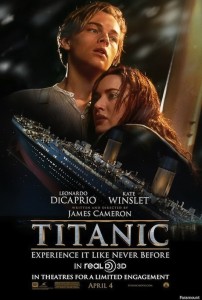 Nowadays it is commonplace for filmmakers to re-release their blockbuster hits into cinemas with a cloak of 3D technology over the original print. George Lucas is the most recent to do so with The Phantom Menace, and will certainly not be the last. These films usually disappoint and leave something to be desired. The average conversion takes around 6 weeks, with average results appearing on screen. Titanic 3D boasts ten times the average conversion time, totalling at 60 weeks, and bringing forth an impressive release that packs a punch as strong as the first time.
Nowadays it is commonplace for filmmakers to re-release their blockbuster hits into cinemas with a cloak of 3D technology over the original print. George Lucas is the most recent to do so with The Phantom Menace, and will certainly not be the last. These films usually disappoint and leave something to be desired. The average conversion takes around 6 weeks, with average results appearing on screen. Titanic 3D boasts ten times the average conversion time, totalling at 60 weeks, and bringing forth an impressive release that packs a punch as strong as the first time.
More than a staggering 275,000 frames were converted to 3D technology during the conversion. Firstly, 4K digital copy of the film was created and then a 3D conversion was completed over the top of it. Producer Jon Landau and writer/director/wonder boy James Cameron were there every step of the way resulting in the best conversion of a previously released non 3D film. In fact, the release is streets ahead of most 3D releases in general.
Having seen Titanic in its original theatrical release twice (a rare occurrence for this writer) and countless times since (I also shamelessly threw at 95th anniversary Titanic party), the re-release was surprisingly effectual. Producer Jon Landau refers to Titanic as an old style Hollywood film, complete with real sets and real effects. Of course, technology did play apart of the films production, but it is undeniable the degree of detail and level of precision that film reaches.
One hundred years has passed since since the ill fated maiden voyage of the RMS Titanic struck an iceberg and sank in the Atlantic Ocean. Stories of passengers and crew members have become legendary, and James Cameron’s 11-time Oscar winning epic in 1997 helped remind the public of the enigmatic mythology of the sinking ship. Costing a record $200 million to make and becoming the highest grossing film in the world (a feat only recently overtaken by James Cameron’s latest epic Avatar), the film of Titanic needs no synopsizing.
The events of 9/11 and other traumatic events add a particular traumatic element upon revisiting the film. Seeing the ship sink, while hundreds of people horrifically drown and falling to their deaths conjures up images of the falling man from the World Trade Centre towers. Reliving these events is naturally traumatic and an undeniable relationship exists between the disaster films that reinterpret tragic events and our experiences of watching them in a removed context. In the post 9/11 age, it is certainly difficult to separate such connections.
For all it’s sophistication, big budget, technical filmmaking elements, Titanic is a moving story of a real life tragedy with great performances from Leonardo DiCaprio and Kate Winslet. As the momentous hundredth anniversary is marked, the 3D conversion of the 1997 Best Picture Oscar winner is simply breathtaking and a must see for any die hard fan, anyone who missed it in its original release and those who wish to be consumed by the wonders of cinema.
Titanic 3D will be theatrically release in Australia on 5 April through 20th Century Fox.






1 Comment